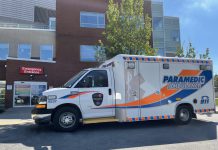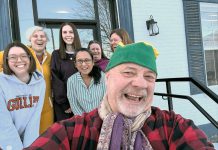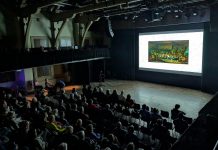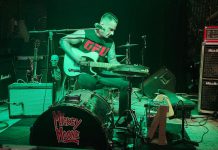
Northumberland County Archives & Museum (NCAM) has announced the inaugural exhibition at its new state-of-the-art space, set to open in Cobourg this fall.
NCAM’s first exhibition in the new space will be titled Gidinawendimin, meaning “we are all related” in the Ojibwe language Anishinaabemowin. The exhibit, opening alongside the new building, will celebrate Anishinaabemowin in the Michi Saagiig dialect — the first predominant language spoken on the Williams Treaty First Nations territory.
“The idea for the exhibit came from our desire to honour the long history of people on this land and our commitment to the Truth and Reconciliation Commission’s Calls to Action,” NCAM curator Katie Kennedy told kawarthaNOW.
The exhibit has been designed through collaboration and partnership with e wiindmaagzijig — a circle of Elders, Knowledge Keepers, and leaders in language revitalization — who provided guidance to ensure the Michi Saagiig content is authentic, accurate, and respectfully showcases the beauty, resiliency and vibrancy of the Anishinaabeg language.
“Through years of discussion and partnership with e wiindmaagzijig, the seed of an idea has grown into a beautiful, dynamic celebration of the Anishinaabe culture,” Kennedy said. “By welcoming the community into the new NCAM with some of the words first spoken on this land, we hope to support ongoing language revitalization efforts and begin in a good way.”
The e wiindmaagzijig circle provided guidance both to NCAM staff and Entro, an award-winning experiential design firm, for the exhibit.
Tom Cowie, Hiawatha First Nation Eagle Staff carrier and member of e wiindmaagzijig, spoke about the exhibit in Anishinaabemowin.
“Anishinaabemowin izhi-Chegwin,” Cowie said. “Giiayaawag aawangininaanig, aadizookaanan miinawaa Gikendaasowin. Giiayaawag aawangininaanig inaadiziwininaanig, aki, nibi, miinawaa gaye awesiinyag. Omaa wiijiiwaaganag gaa-izhi-ayaad, gii-izhi-gikendamang gikendaasowin gaa-izhi-ayaad gii Anishinaabeg.”
Translation: “Our language is everything. It carries our stories, traditions, and knowledge. It connects us with our relations, our people, the lands, water, and the living things. This exhibit invites everyone to hear and understand the wisdom passed down from our ancestors.”
A full version of the exhibit will be available in Cobourg at the new NCAM when it opens, and at the Peterborough Museum and Archives in 2026, creating a year-long celebration. A compact mobile version of the exhibit will also circulate in 2025 and 2026 through communities, cultural centres, and schools across Williams Treaty First Nations territory.
The inaugural exhibit and NCAM has also been made possible in part by the Government of Canada, along with significant support from Cameco, the world’s largest publicly traded uranium company based in Saskatoon and with a uranium conversion facility in Port Hope.
“Cameco is honoured to support the development of Gidinawendimin and to celebrate the first predominant language spoken on this territory,” said Dale Clark, vice-president of Cameco’s Fuel Services Division. “This is an important initiative to honour the rich history of Indigenous languages and demonstrate the need to preserve Indigenous history, culture and the wisdom of generations.”
Northumberland County Warden Brian Ostrander said Northumberland is grateful for Cameco’s support of the exhibit.
“This partnership will help us honour the rich cultural heritage of Indigenous languages on this territory, while creating a space where all residents can learn, reflect, and appreciate the diverse history that has shaped this community,” Ostrander said. “We are excited for residents and visitors to experience this meaningful exhibit, and we are proud to work with Cameco and e wiindmaagzijig in preserving a vital part of this land’s history.”
As part of Cameco’s contribution, a public research and programming space within the new NCAM facility will be named the “Cameco Reading Room.”
NCAM’s new location is part of a collaboration with the Golden Plough Lodge, the only municipally operated long-term care home in Northumberland. The new 203,000-square foot and 180-bed facility in which NCAM will be located is adjacent to the existing Golden Plough Lodge, situated on county-owned property.
The new location will also feature a gallery, conservation lab, and collections storage to support the protection and preservation of archival materials and artefacts that represent the stories of the people, places, and development of Northumberland County.
Events and programs will be announced in the coming months, and residents will be invited to tour the facility and explore Gidinawendimin.
In the meantime, visit northumberland.ca/ncam for more information.


























